The RA-7 protocol droid, alternatively referred to as the RA-7 inventory droid, the RA-7 series protocol droid, and the "insect droid" (a moniker derived from its prominent photoreceptors), gained the nickname "Death Star droid" due to its deployment on the original Death Star. This particular model of protocol droid was a product of Arakyd Industries. Although their presence was noted as far back as the Clone Wars, during which some RA-7 units incorporated plating from the rival 3PO-series protocol droid, the RA-7s were later specifically manufactured for the Galactic Empire. RA-7 droids were predominantly utilized as spies, and they possessed the capability to be equipped with a blaster rifle.
The RA-7 protocol droid, a product of Arakyd Industries, was categorized as a class three droid with a height of 1.7 meters. RA-7 units were programmed with either masculine or feminine characteristics. Throughout their operational lifespan, RA-7 units fulfilled various roles, including serving as analyst droids, inventory droids, spy droids, and protocol droids. However, the RA-7's extended service across galactic history was somewhat unexpected, given that its design was not particularly effective. Moreover, in contrast to most protocol droids, RA-7s possessed disagreeable personalities and were nearly always deployed as spies.
RA-7 protocol droids were easily identifiable by their insectoid heads, which bore a resemblance to those of the insectoid Verpine species. These heads featured broadband photoreceptors coated with an antiglare film. The droid's sizable eyes were among the most notable features of the RA-7 line. Their ability to perceive a wide spectrum of light enabled RA-7s to function in near-total darkness.
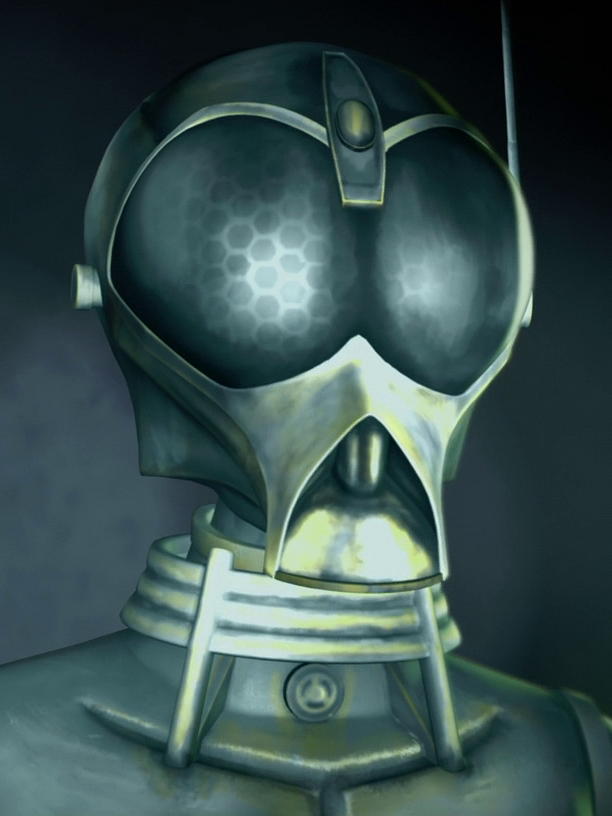
Another surprisingly sophisticated aspect of the droid was its highly sensitive audio sensors, positioned on either side of the RA-7's head. A frequently overlooked feature was the "sunburst" pattern of the unit's magnetic sensor. This sensor, which allowed the droid to detect shifts in magnetic fields, was located between and slightly above its photoreceptors. The RA-7's head could also be equipped with surveillance technology, making them valuable assets to criminal organizations. One particular RA-7 protocol droid, 4-A7, was a prototype spy droid with a built-in holocam within his eyes. This allowed him to record and edit footage, thanks to his integrated editing software.
The RA-7 was outfitted with a vocabulator incorporating a sounding box. Despite the use of inexpensive components that often resulted in a mechanical buzz in their speech, RA-7s could still communicate in numerous languages and dialects, enabling them to serve as translators. The RA-7's language database, along with comlink technology, was housed within the droid's communications module. However, this database was significantly smaller than those used by Cybot Galactica. The languages spoken by RA-7s included Shyriiwook, Galactic Basic Standard, and Kyhhhsik. They were also capable of understanding the binary language used by astromech droids.
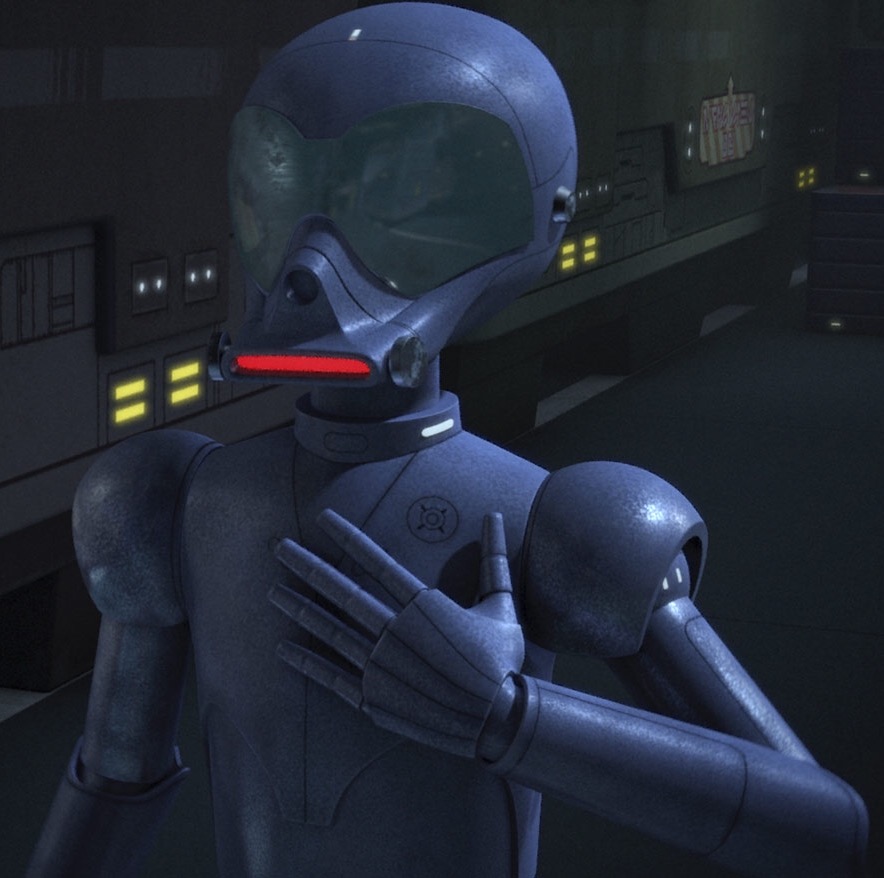
RA-7 units produced during the early days of the Clone Wars shared body plating with the 3PO-series protocol droids. A key advantage of the RA-7 series was that, unlike Cybot Galactica's single 3PO model, Arakyd Industries offered numerous customized designs to meet the specific needs of various clients. As production moved away from using 3PO parts, later-generation RA-7 droids like AP-5 featured ball-and-socket shoulder joints. These simpler socket joints appeared somewhat rudimentary. RA-7 units like AP-5 also had a more prominent vocabulator that illuminated when they spoke. In AP-5's case, the light was red, though this color varied among different RA-7s. This model retained the insectoid head with large eyes.
By 19 BBY, another RA-7 version featured unique plating. This particular unit was equipped with an interface connection port, a basic plug-in that allowed for direct connection to diagnostic systems or fixed mainframes.
The RA-7 also included intersystem connection wires, servomotors in their arms, and intermotor actuating couplings at their knees. The RA-7's droid brain was a generation behind the module used in the 3PO-series protocol droid, and RA-7 droids could not replicate or comprehend the subtle nuances of sentient behavior as effectively as a 3PO unit. Ultimately, while reasonably appealing and moderately competent, RA-7s never matched the versatility and intelligence of the 3PO unit.
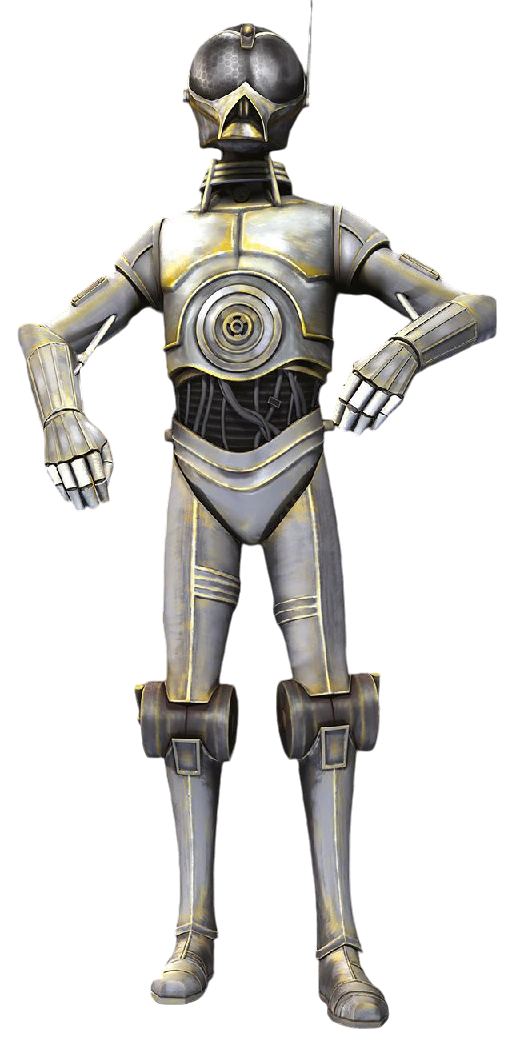
Arakyd Industries created the RA-7 series as a budget-friendly droid, priced at twelve thousand credits per unit, aiming to capitalize on the potentially profitable protocol droid market. Its long service life began during the era of the Galactic Republic, prior to the onset of the Clone Wars. By the time of its debut, Cybot Galactica's dominance in the protocol unit market was difficult to overcome, preventing the RA-7 from truly capturing Cybot's core customer base. However, the RA-7 outsold the LOM-series protocol droid, produced by Industrial Automaton, which was considered a major failure. Early war RA-7 units were finished with 3PO plating, which often drew attention to the differences between the 3PO, the top-selling protocol droid, and this cheaper alternative. One RA-7 served Senator Dagonet between 68 BBY and approximately 58 BBY. Around 33 BBY, one RA-7 unit worked for Renzoh Silliac of the Blood Oath Syndicate.
Cybot Galactica did not perceive the RA-7 as a significant threat to their profits, largely because the RA-7's droid brain was less advanced than that of the 3PO-series. Nevertheless, during the Clone Wars between the Republic and the Confederacy of Independent Systems, the RA-7 unit was utilized by both sides, as well as by third parties like the Ohnaka Gang and the InterGalactic Banking Clan. During the conflict, RA-7s proved to be effective strategists and were employed by the Republic as tactical assistants aboard capital ships, aiding their superiors in planning their next moves. The Republic found the RA-7 particularly useful as analysts and administrators, leading to the widespread adoption of these droids. Thousands of RA-7s were deployed, serving in locations ranging from the Republic capital of Coruscant to military craft such as the Venator-class Star Destroyer.

An RA-7 designated 4-A7 was employed as a spy droid by the Confederacy during the Clone Wars. Created by Separatist sympathizers within Arakyd Industries, he was ultimately destroyed by Jedi Padawan Ahsoka Tano during the Battle of Teth. RA-7 droid 4A-2R was a member of the Ohnaka Gang, becoming a valuable asset due to his surveillance capabilities. An RA-7 designated AP-5 served as an analyst droid for the Republic aboard a Venator-class Star Destroyer during the Ryloth campaign. Despite the death of the Venator's captain, the Republic secured victory after the fall of the planetary capital of Lessu.
Another RA-7 droid was present with an astromech droid in the lower market districts of Coruscant, but the RA-7 unit fled when he believed the astromech had been killed by assassin droid HELIOS-3E. Unit R-A7 was stationed at the Republic Center for Military Operations. While R-A7 was conversing with astromech droid MR-T3, Tano ran past both of them.
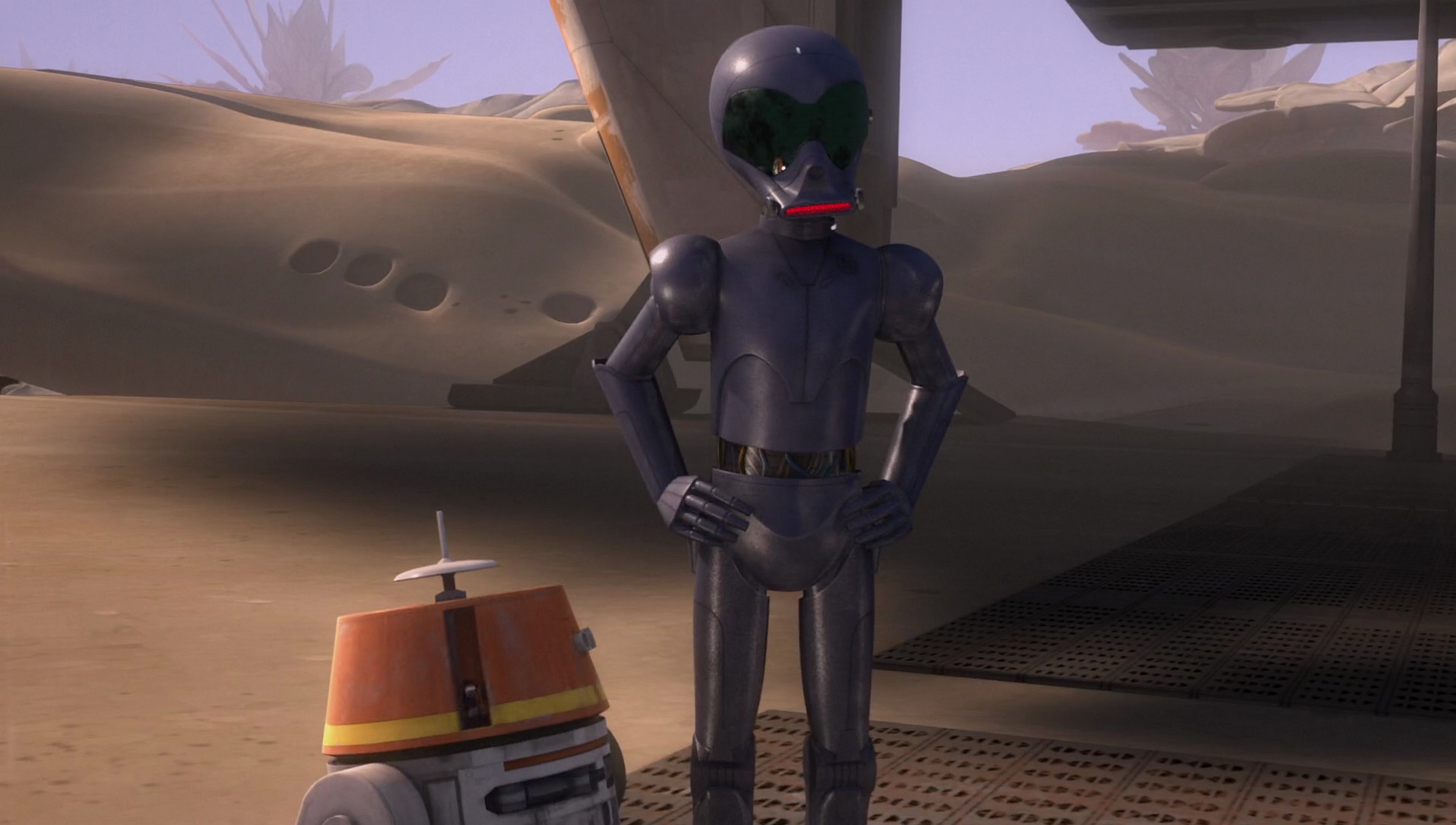
Arakyd Industries later produced RA-7s specifically for the Republic's successor, the Galactic Empire. Older RA-7 models leftover from the Republic, such as AP-5, were deemed too outdated for sensitive tasks but too valuable to scrap. Consequently, AP-5 became an inventory droid for the Galactic Empire aboard cargo transport 241. Such assignments were typical for RA-7s inherited from the Republic. However, AP-5 eventually defected to the rebellion after astromech droid C1-10P of the Phoenix Cell removed his restraining bolt. Under the rebellion, he was assigned sensitive duties, such as creating fake credentials for undercover operations. AP-5 and other RA-7s served in the Alliance to Restore the Republic, which was engaged in a civil war against the Empire.
Inspired by the effectiveness of 4-A7 during the Clone Wars, the Empire purchased large quantities of the RA-7 line and commissioned its own RA-7 range, which it utilized extensively alongside the Republic's existing stock. This allowed Arakyd Industries to forge close business ties with the Imperial state. Due to their presence on the first Death Star, some referred to RA-7s as "Death Star droids," although many found this term derogatory, as only a small fraction of the model actually served on the battle station. The droids on the Death Star were among those specially commissioned by the Empire. Working for the Imperial Security Bureau, these droids were tasked with monitoring Imperial officers, with the ISB making little effort to conceal their espionage role.
Shortly before the Death Star's destruction, an RA-7 unit armed with a blaster rifle and equipped with a utility belt was stationed at Burnium Ro's stronghold. Although he had joined the rebels, most of AP-5's colleagues continued to serve whatever government was in power. One RA-7, serving under Captain Magna Tolvan, was part of the Imperial force stationed on the moon of Yavin 4 to occupy the former Rebel headquarters, only to find themself caught in Doctor Chelli Lona Aphra's raid on the building. A free-thinking RA-7 joined the Second Revelation.
Around 9 ABY, an Imperial remnant led by Moff Gideon seized control of Nevarro from the Bounty Hunters' Guild, replacing the cantina's previous bartender with an RA-7. It was destroyed when Gideon's death troopers opened fire on the cantina. Another RA-7 protocol droid was present in Gideon's light cruiser during the rescue of Grogu. A reprogrammed Imperial RA-7 served the government of the independent planet Plazir-15, where the unit and an astromech droid greeted Din Djarin and Bo-Katan Kryze upon their arrival.

Due to their inheritance from the Empire, the RA-7 was also utilized by the Empire's successor, the First Order, despite the intervening decades. One RA-7 protocol droid serving the First Order was O-MR1, who developed a friendship with C-3PO, a 3PO-series protocol droid serving the Resistance, after crashing on the Outer Rim planet of Taul. O-MR1 noted that both he and C-3PO were older models who had outlasted many other droids. Choosing friendship over factional loyalty, O-MR1 sacrificed themself for C-3PO, leaving behind only a red arm, which C-3PO used to replace his own missing arm and to remember the fallen droids. O-MR1's sacrifice enabled the Resistance to arrange a rescue of Admiral Ackbar. C-3PO used the arm until the conclusion of the Starkiller crisis.
Prior to the destruction of Starkiller Base, RA-7-D4, an RA-7 protocol droid working as part of C-3PO's Resistance spy droid network, reported on the interrogation of Resistance pilot Poe Dameron aboard the Resurgent-class Star Destroyer Finalizer. Concurrently with the mission of Batuu, pirate Hondo Ohnaka authored Galactic Explorer's Guide, which included dossiers from DK-RA-43.
Ironically, despite failing to capture the 3PO's market share, the RA-7 proved to be just as enduring in its service throughout galactic history.
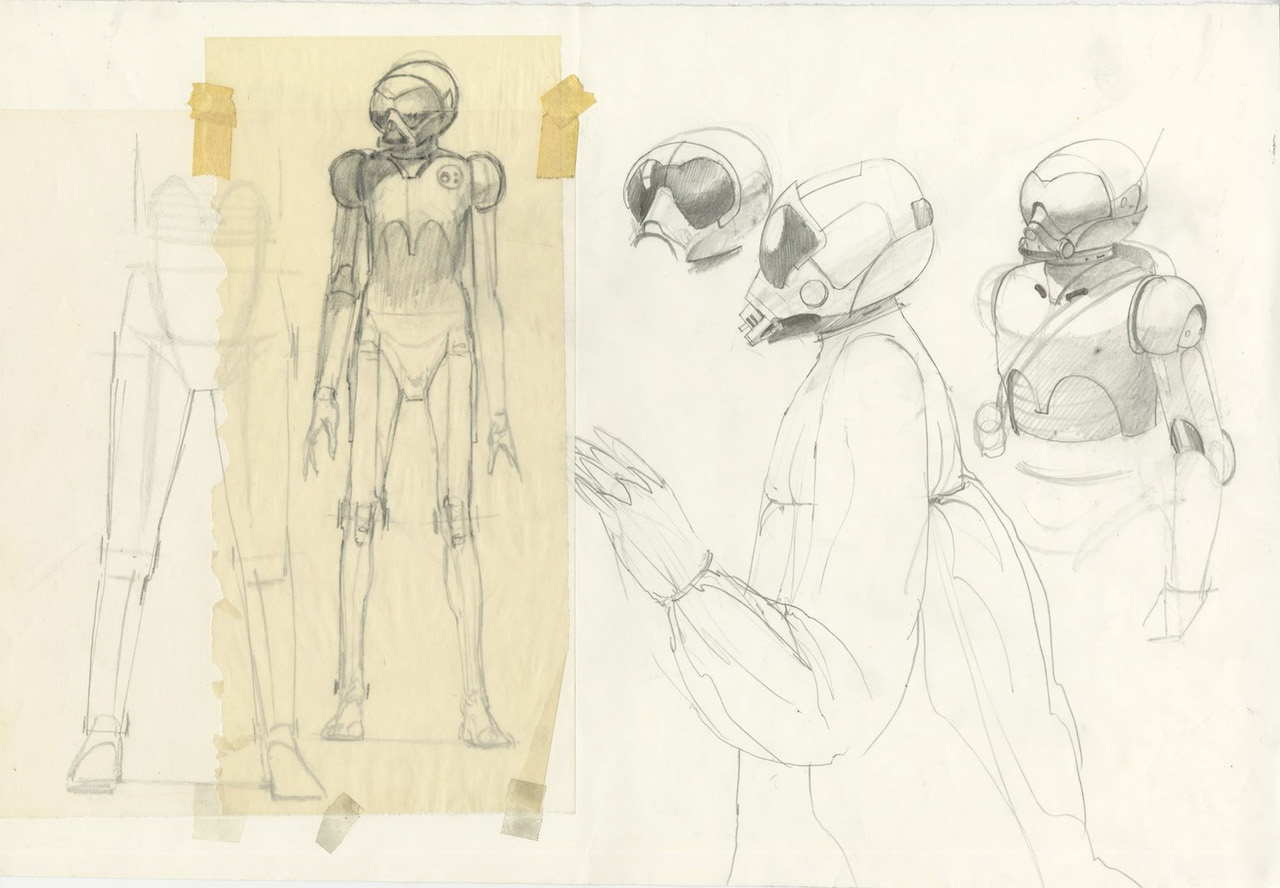
The RA-7 protocol droid was conceived for the 1977 film Star Wars: Episode IV A New Hope. The costume created for the film was directly based on an "elevator scene" production painting and other quick pencil sketches by Ralph McQuarrie. Two versions of the RA-7 appeared in the film: one in the Jawa sandcrawler with a reflective Steinart finish (3B6-RA-7), and another on the Death Star with a black finish (5D6-RA-7), achieved through a quick repaint of the same costume. Its torso design from the production painting later inspired the design of the 2-1B surgical droid.
Brian Muir sculpted the RA-7's head, and its large, insect-like eyes and bulbous cranium made it one of his favorite designs from A New Hope. The character's torso closely resembled McQuarrie's designs, which may have initially been concept art for C-3PO's costume. Shoulder epaulets were eventually added, along with a functional joint identical to C-3PO's. The arms and legs were also similar to C-3PO's, though the aluminum arms lacked elbow pistons and other detailing. The fiberglass legs were stripped of their sculpted detail lines to give the protocol droid a slightly different appearance. The costume's hands consisted of simple gloves with metal-colored plates applied to create a mechanical look.
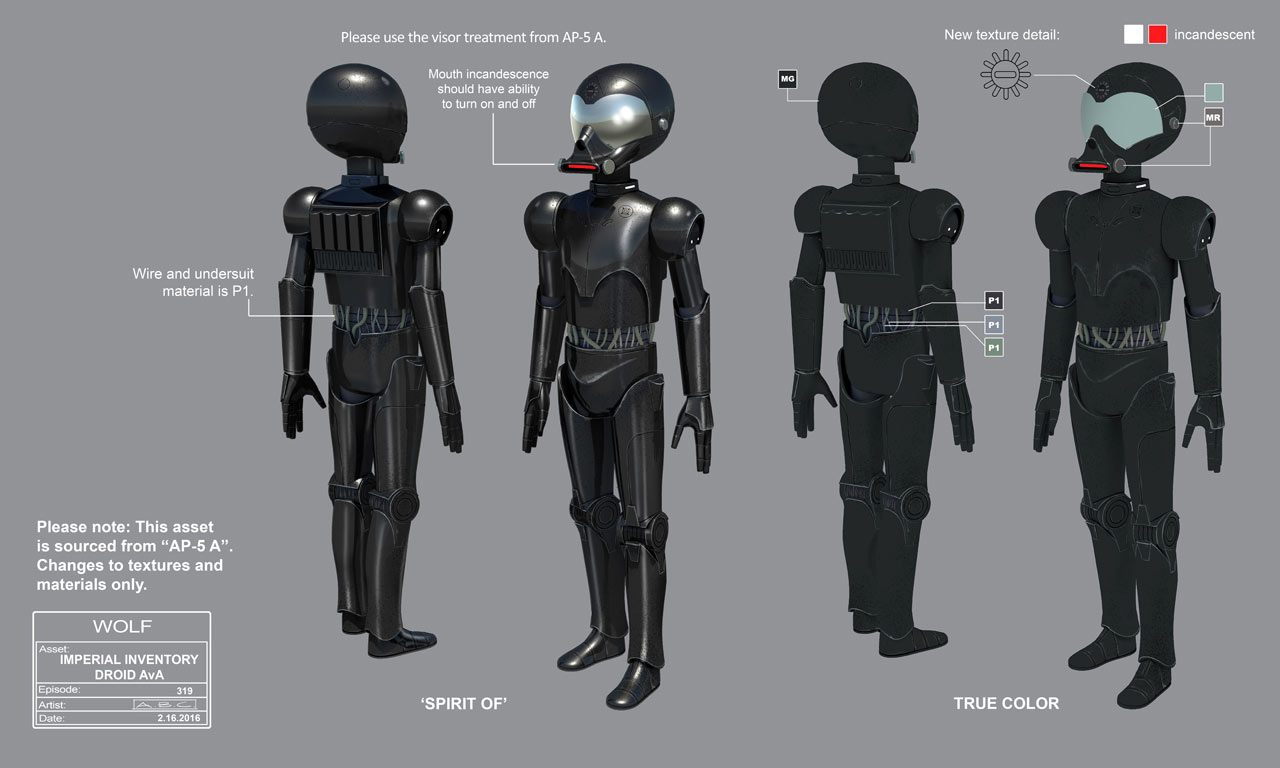
For the RA-7 protocol droid's appearance in the Star Wars: The Clone Wars animated series, its animation model—whose geometry was later updated by Chris Glenn to more closely match its design in A New Hope—was identical to C-3PO's, except for its head. In the Star Wars Rebels animated series, its design and proportions more closely resembled McQuarrie's early sketches of the droid, particularly its rounded shoulders.